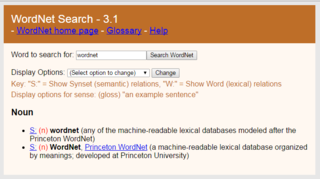
A semantic network, or frame network is a knowledge base that represents semantic relations between concepts in a network. This is often used as a form of knowledge representation. It is a directed or undirected graph consisting of vertices, which represent concepts, and edges, which represent semantic relations between concepts, mapping or connecting semantic fields.
John Florian Sowa is an American computer scientist, an expert in artificial intelligence and computer design, and the inventor of conceptual graphs.
A modeling language is any artificial language that can be used to express information or knowledge or systems in a structure that is defined by a consistent set of rules. The rules are used for interpretation of the meaning of components in the structure.

Object-role modeling (ORM) is used to model the semantics of a universe of discourse. ORM is often used for data modeling and software engineering.

A metamodel or surrogate model is a model of a model, and metamodeling is the process of generating such metamodels. Thus metamodeling or meta-modeling is the analysis, construction and development of the frames, rules, constraints, models and theories applicable and useful for modeling a predefined class of problems. As its name implies, this concept applies the notions of meta- and modeling in software engineering and systems engineering. Metamodels are of many types and have diverse applications.
Semantic integration is the process of interrelating information from diverse sources, for example calendars and to do lists, email archives, presence information, documents of all sorts, contacts, search results, and advertising and marketing relevance derived from them. In this regard, semantics focuses on the organization of and action upon information by acting as an intermediary between heterogeneous data sources, which may conflict not only by structure but also context or value.

Enterprise modelling is the abstract representation, description and definition of the structure, processes, information and resources of an identifiable business, government body, or other large organization.
Machine interpretation of documents and services in Semantic Web environment is primarily enabled by (a) the capability to mark documents, document segments and services with semantic tags and (b) the ability to establish contextual relations between the tags with a domain model, which is formally represented as ontology. Human beings use natural languages to communicate an abstract view of the world. Natural language constructs are symbolic representations of human experience and are close to the conceptual model that Semantic Web technologies deal with. Thus, natural language constructs have been naturally used to represent the ontology elements. This makes it convenient to apply Semantic Web technologies in the domain of textual information. In contrast, multimedia documents are perceptual recording of human experience. An attempt to use a conceptual model to interpret the perceptual records gets severely impaired by the semantic gap that exists between the perceptual media features and the conceptual world. Notably, the concepts have their roots in perceptual experience of human beings and the apparent disconnect between the conceptual and the perceptual world is rather artificial. The key to semantic processing of multimedia data lies in harmonizing the seemingly isolated conceptual and the perceptual worlds. Representation of the Domain knowledge needs to be extended to enable perceptual modeling, over and above conceptual modeling that is supported. The perceptual model of a domain primarily comprises observable media properties of the concepts. Such perceptual models are useful for semantic interpretation of media documents, just as the conceptual models help in the semantic interpretation of textual documents.

The TOVE project, acronym of TOronto Virtual Enterprise project is a project to develop an ontological framework for enterprise integration (EI) based on and suited for enterprise modeling. In the beginning of the 1990s it was initiated by Mark S. Fox and others at the University of Toronto.

The three-schema approach, or three-schema concept, in software engineering is an approach to building information systems and systems information management that originated in the 1970s. It proposes three different views in systems development, with conceptual modelling being considered the key to achieving data integration.
Business Semantics Management (BSM) encompasses the technology, methodology, organization, and culture that brings business stakeholders together to collaboratively realize the reconciliation of their heterogeneous metadata; and consequently the application of the derived business semantics patterns to establish semantic alignment between the underlying data structures.

Ontology engineering in computer science, information science and systems engineering is a field which studies the methods and methodologies for building ontologies: formal representations of a set of concepts within a domain and the relationships between those concepts. A large-scale representation of abstract concepts such as actions, time, physical objects and beliefs would be an example of ontological engineering. Ontology engineering is one of the areas of applied ontology, and can be seen as an application of philosophical ontology. Core ideas and objectives of ontology engineering are also central in conceptual modeling.
Semantic decision tables (SDT) use modern ontology engineering (OE) technologies to enhance traditional decision tables. The term "semantic decision table" was coined by Yan Tang and Prof. Robert Meersman from VUB STARLab in 2006. An SDT is a decision table(s) properly annotated with an ontology. It provides a means to capture and examine decision makers’ concepts, as well as a tool for refining their decision knowledge and facilitating knowledge sharing in a scalable manner.
Semantic Annotations for WSDL and XML Schema (SAWSDL) is a 2007 published technical recommendation of W3C in the context of Semantic Web framework:
Model Driven Interoperability (MDI) is a methodological framework, which provides a conceptual and technical support to make interoperable enterprises using ontologies and semantic annotations, following model driven development (MDD) principles.
OntoUML is a ontologically well-founded language for Ontology-driven Conceptual Modeling. OntoUML is built as a UML extension based on the Unified Foundational Ontology (UFO). The foundations of UFO and OntoUML can be traced back to Giancarlo Guizzardi's Ph.D. thesis "Ontological foundations for structural conceptual models". In his work, he proposed a novel foundational ontology for conceptual modeling (UFO) and employed it to evaluate and re-design a fragment of the UML 2.0 metamodel for the purposes of conceptual modeling and domain ontology engineering.

Bernhard Karl Thalheim is a German computer scientist and Professor of Information Systems Engineering at the University of Kiel who is known for conceptual modeling and its theoretical foundational contributions.
Henderik Alex (Erik) Proper is a Dutch computer scientist, Professor of Information Systems at the Radboud University Nijmegen, and IT consultant, known for work on conceptual modelling of information systems and enterprise engineering.









